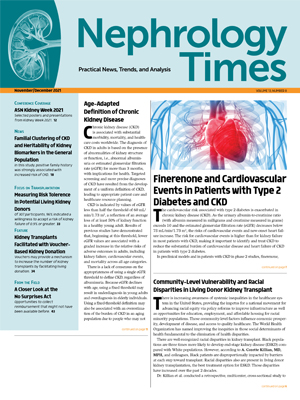
Patients with chronic kidney disease (CKD) and hyperphosphatemia undergoing dialysis are at increased risk for cardiovascular events and all-cause mortality. Calcium-based phosphate binders are inexpensive and well tolerated and are commonly used to improve hyperphosphatemia. However, by increasing the calcium load, calcium-based binders may accelerate vascular calcification, a marker for cardiovascular and all-cause mortality, Updated recommendations from the Kidney Disease: Improving Global Outcomes guidelines call for restriction of the dose of calcium-based phosphate binders for patients with hyperphosphatemia.
Results of a 2018 systematic review were inconclusive regarding whether calcium-free phosphate binders reduced cardiovascular events compared with calcium-based binders. Sevelamer reduced all-cause mortality but not cardiovascular death when compared with calcium-based binders; lanthanum carbonate did not improve all-cause deaths and its effect on cardiovascular events is unknown.
Hiroaki Ogata, MD, and colleagues in Japan conducted the LANDMARK trial comparing composite events to determine whether lanthanum carbonate reduces cardiovascular events compared with calcium carbonate in patients with hyperphosphatemia undergoing hemodialysis at risk of vascular calcification. Results of the study were reported in JAMA [2021;325(19):1946-1954].
The primary outcome of interest was a composite of cardiovascular events: (1) death due to a cardiovascular event (myocardial infarction [MI] or stroke), including cardiac death; (2) nonfatal MI; (3) nonfatal stroke, including transient ischemic attack; (4) unstable angina; (5) hospitalization for heart failure; and (6) hospitalization for ventricular arrhythmia. Secondary outcomes were overall survival, secondary hyperparathyroidism-free survival, hip fracture-free survival, and adverse events. The study period was November 2011 to June 2018, with enrollment from November 2011 to the end of July 2014. A total of 2347 patients were screened for study enrollment. Of those, 2309 patients were randomly assigned to either the lanthanum carbonate group or the calcium carbonate group. The final analysis cohort included 1063 patients in the lanthanum carbonate group and 1072 in the calcium carbonate group (total=2135).
The two groups were well balanced in baseline characteristics, with the exception of lanthanum carbonate and statin use being more prevalent in the lanthanum carbonate group than in the calcium carbonate group. In both groups, median age was 69 years, and 40.5% were female.
Excluding patients who died, follow-up was incomplete for 13.5% of patients in the lanthanum carbonate group (n=143) and 13.2% of those in the calcium carbonate group (n=141). In the lanthanum group, median follow-up was 3.16 years; median follow-up in the calcium carbonate group was 3.16 years.
At baseline, median daily doses were 750 mg for lanthanum carbonate and 1500 mg for calcium carbonate. By month 36, lanthanum had gradually increased to 1500 mg/day; the daily dose of calcium carbonate remained virtually unchanged during the study period. In the lanthanum carbonate group, adjunctive sevelamer use was nearly unchanged in the first 36 months; in the calcium carbonate group, it gradually increased to 27.2%. In the lanthanum carbonate group, there was a consistent increase in the proportion of active vitamin D users throughout the study period; in the calcium carbonate group, active vitamin D use remained nearly flat. The two groups were similar in increase of cinacalcet use.
In the lanthanum carbonate group corrected calcium levels decreased significantly compared with the calcium carbonate group (P<.001 by mixed models for repeated measures analyses); serum phosphate levels increased significantly in the lanthanum carbonate group (P<.001) during the study period. Thus, there was no difference in calcium × phosphate products between the two groups during the study period.
Primary Outcomes
The primary composite end point occurred in 147 of 1063 patients in the lanthanum carbonate group and 143 of 1072 patients in the calcium carbonate group (absolute difference, 0.50 per 100 person-years; 95% confidence interval [CI], –0.57 to 1.56). Following stratification according to age, sex, and diabetes status, the hazard ratio (HR) in the lanthanum carbonate group versus the calcium carbonate group was 1.11 (95% CI, 0.88-1.41). In the per-protocol set, the results were not significantly different (absolute difference, 0.48 per 100 person-years, 95% CI, –0.61 to 1.56; HR, 1.12, 95% CI, 0.86-1.45).
Across prespecified subgroups, the effect of lanthanum carbonate treatment on the primary composite end point was consistent, with no interactions observed. However, in patients undergoing hemodialysis, dialysate calcium concentrations affected the calcium load. There was no significant difference between the groups in the composite cardiovascular events, even at higher corrected calcium levels (≥9.0 mg/dL), higher levels of calcium phosphate products (≥55.0 mg2/dL2), of higher dialysis calcium concentration (≥2.8 mEq/L).
Secondary Outcomes
In the lanthanum carbonate group, there were 159 deaths (incidence rate, 4.96 per 100 person-years; 95% CI, 4.33-5.65), versus 158 deaths in the calcium carbonate group (incidence rate, 4.53 per 100 person-years, 95% CI, 3.93-5.19; absolute difference, 0.43 per 100 person-years, 95% CI, –0.63 to 1.49; HR, 1.10, 95% CI, 0.88-1.37). Cardiovascular mortality was significantly higher in the lanthanum carbonate group compared with the calcium carbonate group (absolute difference; 0.61 per 100 person-years, 95% CI, 0.02—1.21; HR, 1.51, 95% CI, 1.01-2.27; P=.045). Secondary hyperparathyroidism was more frequent in the lanthanum carbonate group, while the incidence of hip fracture during the study period was similar in the two groups.
Adverse Events
There were 282 adverse events in the lanthanum carbonate group and 259 in the calcium carbonate group (25.7% vs 23.4%, respectively). In the lanthanum carbonate group, 63.8% of patients experienced gastrointestinal disorders, compared with 48.6% of patients in the calcium carbonate group. In the lanthanum carbonate group, hyperphosphatemia (>6.0 mg/dL) was more prevalent; hypercalcemia (>10 mg/dL) was more prevalent in the calcium carbonate group.
The researchers cited some limitations to the study, including the low incidence of cardiovascular events; the possibility that dietary calcium intake in this study population may be lower than in previous trials in Western countries; the possibility that concomitant use of active vitamin D, sevelamer, and cinacalcet and the use of higher dialysate calcium concentrations may have affected trial results; including participants from one country only; and the possibility that the results may not be generalizable to patients with overt secondary hyperparathyroidism.
In conclusion, the authors said, “Among patients undergoing hemodialysis with hyperphosphatemia and at least one vascular calcification risk factor, treatment of hyperphosphatemia with lanthanum carbonate compared with calcium carbonate did not result in a difference in composite cardiovascular events. However, the event rate was low, and the findings may not apply to patients at higher risk.”
Takeaway Points
- Researchers reported results of a study designed to compare composite cardiovascular events between a group of patients undergoing dialysis treated with lanthanum carbonate (a calcium-free phosphate binder) and those treated with calcium carbonate.
- The trial included patients with at least one risk factor for vascular calcification. There were no significant differences between the two groups in composite cardiovascular events.
- However, the event rates were low and the findings may not apply to patients at higher risk.







 © 2025 Mashup Media, LLC, a Formedics Property. All Rights Reserved.
© 2025 Mashup Media, LLC, a Formedics Property. All Rights Reserved.